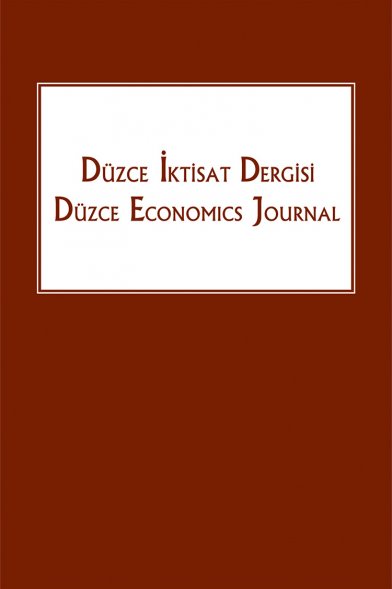Türkiye'de Askeri Harcama Yakınsaması: Fourier Birim Kök Testinden Kanıtlar
Askeri Harcama, Yakınsama, Fourier Birim Kök
Convergence in Turkey Military Spending: Evidence from the Fourier Unit Root Test
Military Spending, Convergence, Fourier Unit Root,
___
Apergis, N., Christou, C., & Hassapis, C. (2013). Convergence in public expenditures across EU countries: evidence from club convergence. Cogent Economics & Finance, 1(1), 862735.
Arvanitidis, P., Kollias, C., & Anastasopoulos, K. (2014). Is there an international convergence in defence burdens? Some initial findings. Peace Economics, Peace Science and Public Policy, 20(4), 611-620.
Arvanitidis, P., & Kollias, C. (2016). Converging defence burdens? Some further findings. Peace Economics, Peace Science and Public Policy, 22(4), 365-375.
Arvanitidis, P., Kollias, C., & Messis, P. (2017). Converging allies?. Peace Economics, Peace Science and Public Policy, 23(2).
Baumol, W. J. (1986). Productivity growth, convergence, and welfare: what the long-run data show. The american economic review, 1072-1085.
Enders, W., & Lee, J. (2012). The flexible Fourier form and Dickey–Fuller type unit root tests. Economics Letters, 117(1), 196-199.
Friedman, M. (1992). Do old fallacies ever die?Journal of Economic Literature, 30, 2129–2132.
Güri̇ş, S., Güriş, B., & Tiraşoğlu, M. (2017). Do military expenditures converge in NATO countries? Linear and nonlinear unit root test evidence. Theoretical & Applied Economics, 24(2) 237-248.
Hatemi-J, A. (2012). Asymmetric causality tests with an application. Empirical Economics, 43(1), 447-456.
Herrerias, M. J., & Liu, G. (2013). Electricity intensity across Chinese provinces: New evidence on convergence and threshold effects. Energy Economics, 36, 268-276.
Islam, N. (2003). What have we learnt from the convergence debate?. Journal of economic surveys, 17(3), 309-362.
Lau, C. K. M., Demir, E., & Bilgin, M. H. (2016). A nonlinear model of military expenditure convergence: Evidence from estar nonlinear unit root test. Defence and Peace Economics, 27(3), 392-403.
Lin, E.S., Ali, H.E. & Lu, Y-L. (2015). Does Military Spending Crowd Out Social Welfare Expenditure? Evidence from a Panel of OECD Countries. Defence and Peace Economics, 26(1), 33-48.
Liu, T. Y., Su, C. W., Tao, R., & Cong, H. (2019). Better is the Neighbor?. Defence and peace economics, 30(6), 706-718.
Maior, G.C. & Matei, M. (2003). Bridging the Gap in Civil-Military Relations in Southeastern Europe: Romania’s Defense-Planning Case. Mediterranean Quarterly, 14(2), pp. 60-76.
Peled, D. (2001). Defense R&D and Economic Growth in Israil: A Research Agenda, Haifa: Samuel Neaman Institute.
Quah, D. (1993). Galton’s fallacy and tests of the convergence hypothesis. The Scandinavian Journal of Economics, 95, 427–44.
Sawhney, B., Anoruo, E., & DiPietro, W. R. (2016). The world distribution of military spending: is there a convergence?. International Journal of Computational Economics and Econometrics, 6(4), 351-365.
SIPRI (2017). Stockholm international peace research institute yearbooks world armament and disarmament. Oxford: Oxford University Press.
Solarin, S. A. (2018). Determinants of military expenditure and the role of globalisation in a cross-country analysis. Defence and Peace Economics, 29(7), 853-870.
Solarin, S. A. (2019). Convergence of defence burdens in Asia-pacific economies: A residual augmented least squares approach. Peace Economics, Peace Science and Public Policy, 25(2).
Treddenick, J. (1985). The Arms Race and Military Keynesianism. Canadian Journal of Public Policy, 5, 64-80.
Yazgan, Ş., Ceylan, R., & Mollavelioğlu, M. Ş. (2018). Seçilmiş NATO ülkelerinde askeri harcamaların yakınsaması: Doğrusal olmayan birim kök testinden kanıtlar. Akdeniz İİBF Dergisi, 18(37), 118-132.
Yilanci, V., Eryüzlü, H., & Hopoğlu, S. (2020). Convergence of Military Burdens in the MENA Region. Uluslararası İlişkiler/International Relations, 17(66), 41-59.
- ISSN: 2757-6558
- Yayın Aralığı: Yılda 2 Sayı
- Başlangıç: 2020
- Yayıncı: Şerif CANBAY
Türkiye'de Askeri Harcama Yakınsaması: Fourier Birim Kök Testinden Kanıtlar
Kripto Paraların Dünya Genelindeki Hukuki Durumuna İlişkin Bir İnceleme
Türkiye İçin Cari İşlemler Dengesi Beklentilerinin Rasyonalitesi Üzerine Ekonometrik Bir Analiz
Hisse Senedi Fiyatlarının Ortalamaya Dönüşü: Kesirli Frekanslı Fourier ADF Birim Kök Testi
